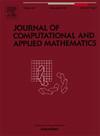IMEX BDF方法对DDEs和PDDEs的稳定性研究
IF 2.6
2区 数学
Q1 MATHEMATICS, APPLIED
Journal of Computational and Applied Mathematics
Pub Date : 2025-10-01
DOI:10.1016/j.cam.2025.117044
引用次数: 0
摘要
本文基于检验方程y ' (t)= - Ay(t)+By(t−τ),研究了延迟微分方程(DDEs)的IMEX-BDF方法的稳定性,其中τ是一个常数延迟,a在R+中对角化,而B可以是任何矩阵。首先,分析了两个矩阵同时对角化的情况,并证明了获得线性稳定性的充分条件。然而,本文主要讨论了矩阵A和B不能同时对角化的情况。利用F(⋅)的值域概念证明了这些方法无条件稳定的一个充分条件:如果a是埃尔米数,则每当F(a−1B)在圆心为0、半径为13,d(0,13)的圆盘中时,imex - bdff2都是无条件稳定的,而每当F(a−1B)≥0,17时,IMEX-BDF3都是无条件稳定的。进一步,导出了保证稳定性的充分条件,但根据步长作为包含F(a−1B)的圆盘半径的函数。通过几个例子说明了本文提出的方法,其中所讨论的理论不仅适用于微分方程,而且适用于由带扩散项的偏延迟微分方程给出的抛物问题。本文章由计算机程序翻译,如有差异,请以英文原文为准。
On the stability of IMEX BDF methods for DDEs and PDDEs
In this paper, the stability of IMEX-BDF methods for delay differential equations (DDEs) is studied based on the test equation , where is a constant delay, diagonalizes in , but might be any matrix. First, it is analyzed the case where both matrices diagonalize simultaneously, and sufficient conditions to obtain linear stability are proved. However, the paper focuses on the case where the matrices and are not simultaneously diagonalizable. The concept of field of values, denoted by , is used to prove a sufficient condition for unconditional stability of these methods: if is Hermitian, IMEX-BDF2 is unconditionally stable whenever is contained in the disk centered at 0 and radius , , while IMEX-BDF3 is unconditionally stable whenever . Furthermore, sufficient conditions are derived to ensure stability, but according to the step size as a function of the radius of the disk containing . The approach developed herein is illustrated through several examples in which the discussed theory is applied not only to DDEs, but also to parabolic problems given by partial delay differential equations (PDDEs) with a diffusion term.
求助全文
通过发布文献求助,成功后即可免费获取论文全文。
去求助
来源期刊
CiteScore
5.40
自引率
4.20%
发文量
437
审稿时长
3.0 months
期刊介绍:
The Journal of Computational and Applied Mathematics publishes original papers of high scientific value in all areas of computational and applied mathematics. The main interest of the Journal is in papers that describe and analyze new computational techniques for solving scientific or engineering problems. Also the improved analysis, including the effectiveness and applicability, of existing methods and algorithms is of importance. The computational efficiency (e.g. the convergence, stability, accuracy, ...) should be proved and illustrated by nontrivial numerical examples. Papers describing only variants of existing methods, without adding significant new computational properties are not of interest.
The audience consists of: applied mathematicians, numerical analysts, computational scientists and engineers.

 求助内容:
求助内容: 应助结果提醒方式:
应助结果提醒方式:


